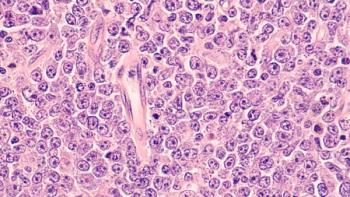
Non-O Blood Types May Be Linked to Venous Thromboembolism in Patients With Cancer
New research suggests that blood type may be an easily accessible predictor of venous thromboembolism risk.
Patients with cancer who have non-O blood types may be at a time-dependent increased risk of venous thromboembolism (VTE), according to results of a study published in Blood Advances. Specifically, patients in this population are an increased risk once they reach 3 months of follow-up, and among patients with intermediate- and low-risk tumor types.
Overall, at a median follow-up time of 24 months (interquartile range, 10-24), 151 patients with cancer developed VTE out of 1708 evaluable patients (8.8%). There was no reported association between non-O blood type and VTE risk observed within the first 3 months of follow-up (sub-distribution hazard ration [SHR], 1.00; 95% CI, 0.60-1.67).
However, beyond that time marker, a connection between the adverse event (AE) and the factor began to emerge (SHR, 1.79; 95% CI, 1.12-2.85). Notably, the association was only present in patients with intermediate- and low-thrombotic risk tumor types (SHR 1.73; 95% CI, 1.09-2.73), but not in high-risk tumor types such as pancreatic, gastroesophageal, and brain cancer (SHR 0.94; 95% CI, 0.55-1.61).
“In this prospective observational cohort study, we have shown that ABO blood type is associated with risk of VTE in patients with cancer in a time-dependent manner,” the study authors wrote. “These results indicate that cancer may be the main driver of the increased risk of VTE shortly after diagnosis or progression, depicting a time when the cancer is very active and patients are receiving anti-cancer therapies, putting them at high risk for VTE. This time period is also the one with the highest incidence of VTE in patients with cancer.”
Patients with cancer are 5-9 times more likely to experience VTE and VTE among this population is associated with poor prognoses; in addition, routine thromboprophylaxis is not recommended for these patients because they are at an increased risk of bleeding. Since the general population has non-O blood types, researchers sought to understand the relationship between this event and ABO blood types.
“Current guidelines recommend pharmacological thromboprophylaxis in patients with high VTE risk that are most likely to benefit,” the authors noted. “Therefore, better understanding of risk profiles and identification of simple risk factors contributing to elevated risks of VTE is desired to aid in clinical decision making.”
Investigators conducted an analysis with the Vienna Cancer and Thrombosis Study (CATS)– a prospective cohort study which evaluated patient with newly diagnosis or recurrent cancer. Investigators performed restricted cubic spline analysis and specific time-restricted subdistribution hazard ratios to determine the association between non-O blood type and VTE over time.
Eligible patients were older than 18 years, had histologically confirmed cancer, and were either newly diagnosed or had disease progression following partial or complete remission.
Patients were ineligible if they had received chemotherapy or experienced VTE in the last 3 months, or had long-term anticoagulation, overt viral or bacterial infection, radiotherapy, or surgery 2 weeks prior to study inclusion.
Patient were followed for 2 years and contacted via postal mail and phone to gather information about their clinical outcomes. If patients did not respond, their family doctor or relatives were contacted.
At a median follow-up of 24 months, the 3-, 6-, 12-, and 24-month cumulative VTE occurrences were 3.6% (95% CI, 2.7-4.5), 6.2% (95% CI, 5.1-7.5), 7.8% (95% CI, 6.6-9.2) and 9.2% (95% CI, 7.9-10.7), respectively. A total of 649 deaths occurred throughout the 2-year observation period with a 2-year mortality rate of 38%.
Among the 1708 patients included in the study, 794 were female (46%) and the median age was 61 years (interquartile range, 52-68 years). Lung cancer represented the most common tumor type (19%), and was closely followed by breast cancer (16%) and brain cancer (14%). At the study inclusion, 32% of patients with solid tumors presented metastatic disease.
Among the ABO blood types included in the study, 653 (38%) were blood type O, 682 were type A (40%), 262 were type B (15%), and 111 were type AB (7%), which is typical of a European population.
ABO blood group distribution was not varied across patients with different tumor types and corresponding tumor risk categories. In addition, there was no association between having stage 3 disease at study inclusion and belonging to either blood group O versus non-O. No association between ABO blood type group and survival was observed.
Overall, the findings suggest “that non-O blood type acts as a putative predictor of VTE in patients with cancer at comparatively low risk of thrombosis,” the authors concluded. “ABO blood type group is an easily accessible VTE predictor that can help in the clinical practice during risk assessment in patients with cancer.”
Reference
Englisch C, Moik F, Nopp S, Raderer M, Pabinger I, Ay C. ABO blood group type and risk of venous thromboembolism in patients with cancer. Blood Adv. Published online April 13, 2022. doi:10.1182/bloodadvances.2021006283.
Newsletter
Knowledge is power. Don’t miss the most recent breakthroughs in cancer care.

















































































